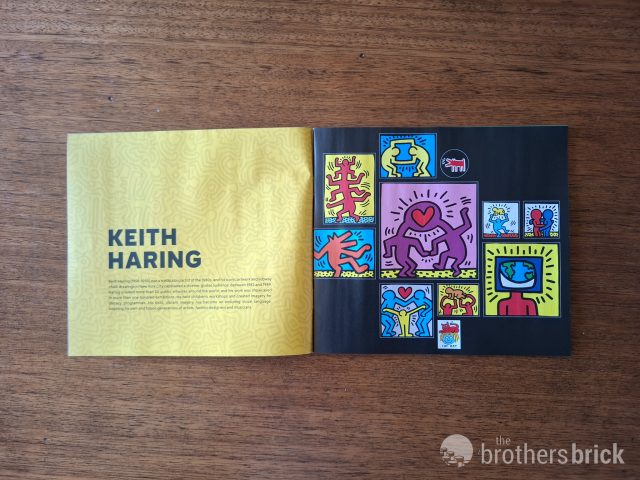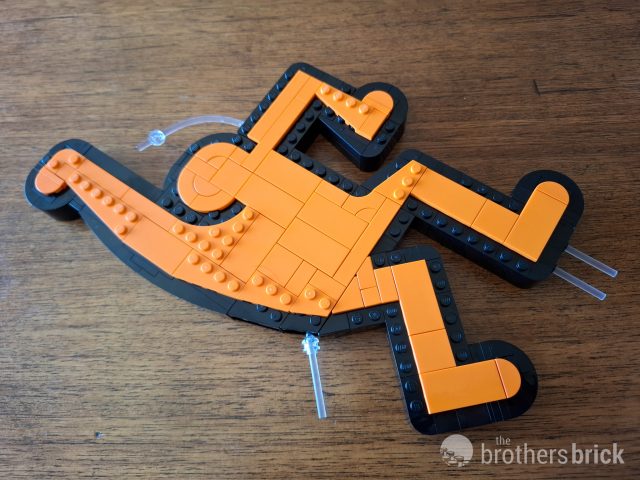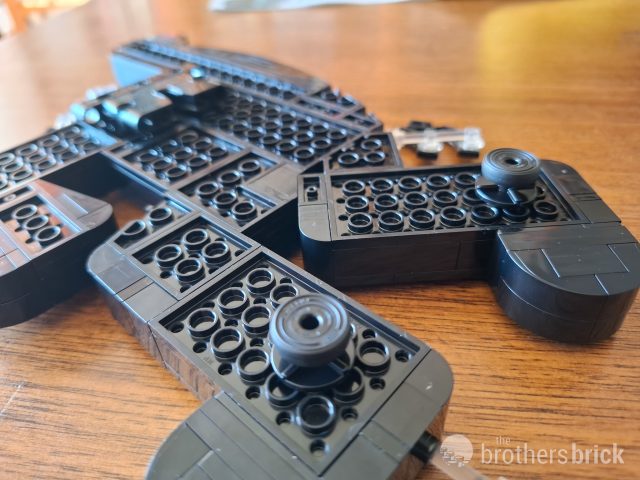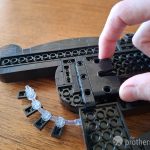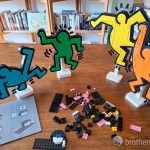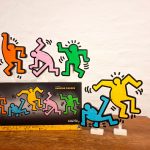LEGO’s Art line has proven a popular way to engage with iconic artwork, with sets that translate brushstrokes into bricks that you can hang on your wall. The newest addition to the line, LEGO Art 31216 Keith Haring – Dancing Figures, shakes up the formula with a playful interpretation of the pop artist’s work that invites sharing the build experience with others. And instead of one finished work, you get 5 pieces that you can display your own way. For this review, I’ll be taking LEGO’s suggestion and inviting my family to join in for a social build experience. If you have others to share the build with, I recommend that you try this as well. As Keith Haring famously said, “art is for everybody.” But is this set for you? Let’s dig in!

Keith Haring – Dancing Figures will hit shelves and walls this May 15th for US $119.99 | CAN $149.99 | UK £104.99.
The LEGO Group sent The Brothers Brick an early copy of this set for review. Providing TBB with products for review guarantees neither coverage nor positive reviews.
Unboxing the set and contents
The front of the box features the now standard LEGO art greeble bar in yellow and shows the five titular Dancing Figures against a black background. There’s a Group icon indicating the set can be enjoyed by 1-5 builders. Sometimes I find these collaborative suggestions to be a bit of a stretch (like the suggestion on the Chopper droid model) but in this case, it’s a great suggestion – I might go so far as to say it’s essential for making the most of the kit. The back of the box shows the alternate display options – with stands or hung on the wall.
Inside the box there are thirteen numbered paper bags and an envelope with five instruction books. There are no stickers. I wish that each instruction book was clearer about which bags they use, as that would be a trivial addition to the cover that would make the social build a little bit easier. In case you’re wondering about that odd number, it’s because the yellow model is a little bigger and gets 4 bags of parts. Keep that in mind if you’re building with a group in case anyone is drawn to or wants to avoid a bigger build.
The first instruction book (orange figure – again, why not number them?) includes 6 pages of notes about the artist and design process. The paragraph of background on Keith Haring is welcome, but I wish LEGO would better use this platform to go a little bit deeper as they do with some of their more premium pre-build pages. The notes from the design team are more marketing speak than insights to spark curiosity and passion in LEGO as a creative medium. The set designer isn’t credited.
The parts

With five brightly colored figures, the set includes numerous new recolors. For specifics on which pieces are new, visit our friends at New Elementary where they apply their expert eye to the set’s parts.
The build
As mentioned in the introduction, I shared this build experience with family so the review format will be a little different. The first section breaks down the assembly of one figure in more detail. Each figure has specific differences, but the process is quite similar. A second section will go into the collaborative experience.
Solo Build
Each figure is unique but they all start with some variation of a torso that is made of a layer of bricks sandwiched between two layers of plates. The finished model is 6 plates thick, the top layer of which is reserved for the figure’s unique colored tiles.

Plenty of SNOT (studs not on top) bricks are added early to support connecting the curved black outlines.
The plate rotated 45* seen here is a real workhorse in the figures allowing for many of the distinctive angles.
Another excellent technique used many times throughout the models is the use of 1×2 rounded brick with shaft as a way to clip on sub-builds for the black outline.

Jumping ahead to a different model, I did encounter one very unusual technique in which a triangular tile is dropped into place without a stud connection. Part of it will be covered in the next step, but I found it pretty surprising to see this in an official set.

Over the course of three bags, (4 if you’re building the yellow dude), you’re constantly switching between building structural supports, studless exterior edges, and colorful tiled surfaces, which keeps things interesting.

Midway through the final bag, the figure is complete, with a few transparent bars sticking out to support the dynamic motion lines from Haring’s work.
Clip those on and you’re ready to prepare your mounting options.

A standard LEGO Art hanger snaps on with Technic pins around the neck (or alternate center of gravity depending on the pose). Rubber tires are attached to these fixed axles to serve as bumpers keeping it balanced in place when using the wall mounting method.
The final step of each model has you build the stand. Each stand is a different height and conveniently has a single colored brick on the back to remind you which goes to which. The model can be fixed to the stand via two Technic prongs that slot into the wall hanger.
Family Build
Up to five builders can each build a different figure in parallel. I shared the remaining builds with my partner and kid. Everyone got to pick the figure that called to them. Then we divvied up the bags.
We ripped open our first bags and were off to the races! If you are building with others, be careful to allow plenty of space between each pile of bricks, as aside from the colorful tiles, most other elements are found in multiple models.

As we progressed, we took a moment to see how everyone was feeling about the process. The set is labeled 18+, but often age ratings are a poor indicator of build complexity. My kid (10) wasn’t having any issues with the first bag. My partner, who builds less often, was encountering some techniques for the first time. She also called out some ways in which the instructions were hard to follow.

This build includes quite a lot of steps that alternate between stacking bricks on top and snapping bricks underneath what came before. Sometimes it can be hard to parse where the underneath studs are supposed to align, especially if you’re less experienced. This is compounded by a lot of black-on-black steps. If building collaboratively, be generous with patience and expect some mistakes along the way.

Everyone agreed, these modular clip elements were a highlight. It’s quite satisfying the way they snap into place and leave a smooth curved surface.

As we pressed on, a couple more challenges came up. First, during some steps where you’re building out limbs or joints, there will be times when the connection points aren’t reinforced and parts can break off easily, especially as you alternate between building on top or underneath what came before. This is especially challenging with the azure blue figure, which might be the smallest figure but, as we discovered, is the most complex to build. We found that when things get fragile, it really helps to build on a flat surface and not try and hold the section you’re working on in your hand.

My kid was the first to reach the end of the build, at which point she pointed out the extra parts. As with any set, you’ll get duplicates of a few small elements by design, but there was one substantial part that I recognized at once as something LEGO would not provide a dupe of. She had missed something, and on a quick inspection, I saw where. Here’s where I learned a valuable lesson. Choose your battles when helping a kid correct their mistakes! Repairing the gap from the missing piece required dismantling a fair amount and building back up. I did my best to explain and let her fix it, but while she did succeed, it took her moment of victory and capped it with a period of frustration. Dad lesson learned. I wonder if you’ve ever had an experience like this with a kid and how you handled it?

At last, everyone finished their model! At this point, the others were ready to call it a day, so I finished the last model mostly on my own with a little help from the kid. Building on my own, not stopping for photographs, it took about an hour for a figure. A leisurely build with less experienced builders is about 2 hours for a figure.
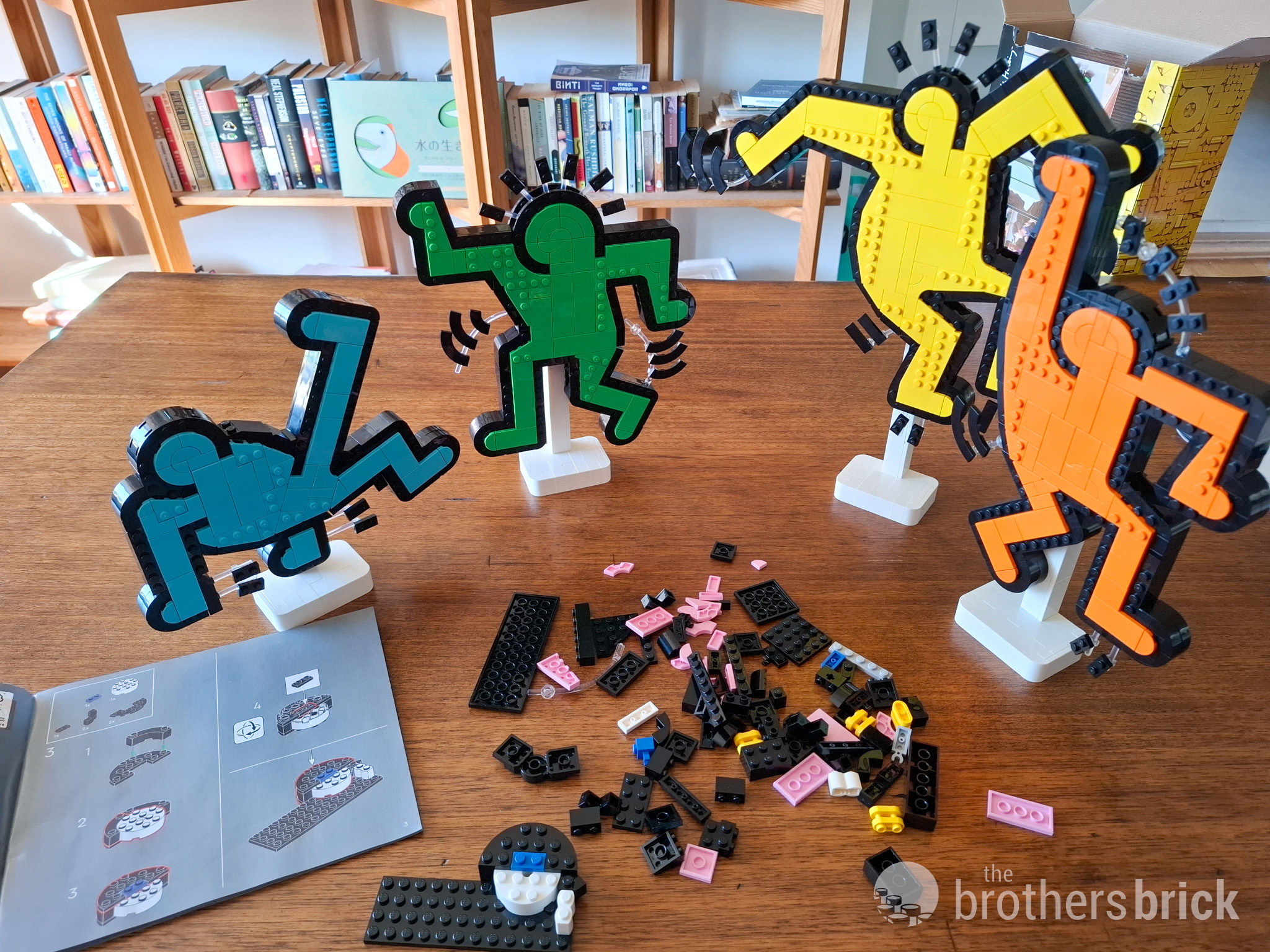
The finished model
The finished models perfectly capture the graffiti style of Keith Haring with the thick lines and energetic figures. The mix of curves and angles are captured so distinctly that I still can’t believe they’re achieved with standard bricks and no new molds. I’m also struck by how good the motion lines look. They really pop and the clear supports fade away. Kudos to the designers for making something that is both distinctly LEGO but doesn’t look like any LEGO set that came before it.

I was only able to test the display stands for all 5 as I didn’t have supports to hang all 5, but testing one, they are easy to hang require a lot smaller footprint. Next stop, the hardware store to get more hangers!
Conclusion and recommendation
Keith Haring’s vibrant and energetic pop art turns out to be an ideal match for LEGO. The finished model is eye-catching and fun, and the ability to display on the wall or on a shelf is welcome. While LEGO only shows them arranged in one sequence, there’s no reason why you shouldn’t take liberties and change the order or display them separately. Together the figures have a substantial presence and along with a generous piece to price ratio, the set feels very much worth the asking price.

As I hinted at in the intro, I strongly recommend this build as one you share. Building one figure over an hour or two is a delightful experience – a bit challenging with some fairly advanced techniques and occasionally obtuse instructions, but ultimately a rewarding one. Building more than one figure sees definite diminishing returns, as while each figure is unique, most of the techniques used to achieve the wild angles and elegant curves will be repeated. Magic moments become routine. Better to spread out the joy. If you build the set with friends and have a great time doing so, why not let everyone keep their figure as a reminder of the experience? I’m sure Keith Haring would have approved.
Keith Haring passed away in 1990 when he was just 31 years old. In his final year, he set up a foundation to further his philanthropic work. You can learn more about the artist and his mission here.
LEGO Art 31216 Keith Haring – Dancing Figures contains 1,773 pieces and will be available on May 15th for US $119.99 | CAN $149.99 | UK £104.99 It may also be available from third-party sellers on eBay and Amazon.
The LEGO Group sent The Brothers Brick an early copy of this set for review. Providing TBB with products for review guarantees neither coverage nor positive reviews.






